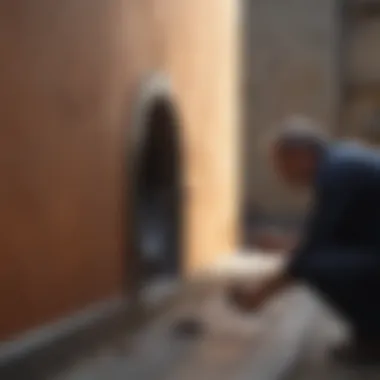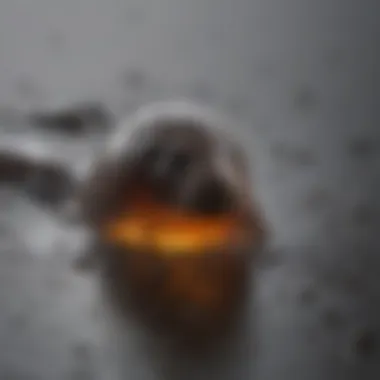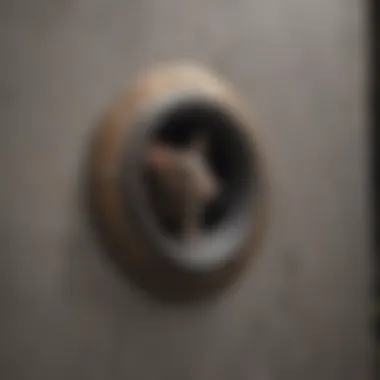Effective Methods to Seal Holes and Prevent Mice


Intro
Mice infestations can pose significant problems for both homeowners and businesses. Understanding how to effectively seal entry points is vital in preventing these pests from infiltrating your space. This article presents a comprehensive guide on how to plug holes and keep mice out, ensuring that you have the knowledge and tools necessary to secure your environment.
Understanding the Pest
Identification
Mice are small rodents that belong to the family Muridae. They vary in species, but the most common types found in homes are the house mouse and the field mouse. Adult house mice can grow to about 3 to 4 inches in length, excluding their tails. They have pointed snouts, large ears, and short hair. Identifying these features can help you locate and confirm a mouse problem in your premises.
Life Cycle
Understanding the life cycle of mice is essential when considering prevention strategies. Mice reproduce quickly, with females capable of giving birth to several litters per year. Each litter can contain as many as 10 young, who reach maturity within weeks. This rapid reproduction means that an early intervention is crucial to prevent an infestation from spiraling out of control.
Pest Prevention Strategies
Environment Modification
Modifying your environment can significantly deter mice from entering your space. Here are some practical steps:
- Keep food stored in airtight containers.
- Reduce clutter that serves as hiding spots.
- Regularly clean areas where food crumbs may accumulate.
Physical Barriers
Creating physical barriers is one of the most effective ways to keep mice out. Sealing gaps and holes stops mice from entering. Common methods include:
- Caulking: Use a high-quality caulk to seal small cracks and crevices.
- Steel Wool: This material can plug larger holes; mice cannot gnaw through it.
- Foam Sealant: Expanding foam sealants fill larger gaps, providing a solid barrier against entry.
Control Methods
Chemical Control
While the focus here is on prevention, it is important to acknowledge that chemical control methods can be utilized in a managed approach. Use rodenticides only if absolutely necessary. Be cautious, as these chemicals may harm pets, children, and non-target wildlife.
Biological Control
Biological control methods can include encouraging natural predators, such as cats, to manage mouse populations. This method is less common but can be effective, particularly in larger outdoor areas.
"An integrated approach combining environmental awareness, physical barriers, and, when needed, control methods, is essential for effective pest management."
Maintaining vigilance and regularly inspecting your property are vital components of preventing mice infestations. Taking these proactive measures can save time and money while ensuring a comfortable living or working environment.
Understanding the Problem
Preventing mice infestation is crucial for maintaining a safe and healthy living environment. Mice not only compromise food safety but can also damage property and spread diseases. Understanding the urgency of rodent control can inform better decisions regarding home maintenance.
The Importance of Rodent Control
Rodent control is essential for several reasons. Firstly, mice are known carriers of various diseases such as hantavirus and leptospirosis. Their droppings and urine can contaminate surfaces, leading to potential health risks for humans.
Additionally, mice are often a sign of a larger issue. They can multiply quickly, turning a minor problem into a significant infestation. Once established, they can cause economic harm by chewing through electrical wiring and insulation, which can result in costly repairs. Therefore, a proactive approach to rodent control not only safeguards health but also protects property value.
Identifying Common Entry Points
Knowing where mice can enter a property is vital in preventing infestations. Common entry points include:
- Small Cracks and Gaps: Mice can squeeze through openings as small as a quarter of an inch. Inspect areas around windows, doors, and foundations for cracks that may serve as entry points.
- Ventilation Spaces: Grills and vents that are not properly sealed can provide easy access.
- Pipes and Wires: Gaps around pipes or wires coming into the house can be a significant entry route.
A thorough assessment of these areas can help in sealing potential entry points before mice can enter. Invest time in inspection as an effective strategy that could save future costs related to pest control.


Assessing Your Space
Assessing your space is a critical step in the process of keeping mice out. By evaluating your environment thoroughly, you can identify vulnerabilities that may serve as entry points for rodents. A structured assessment not only helps in pinpointing these areas but also aids in the formulation of an effective prevention strategy. Investing time to assess your space can save you the hassle of dealing with pest issues later.
A successful inspection requires attention to detail. This includes examining the interior and exterior of your property, as well as recognizing patterns in mouse behavior. Mice often seek shelter, food, and warmth, so understanding their needs can direct your evaluation. Regular assessments of your space fortify your defenses against potential infestations.
Conducting a Thorough Inspection
Conducting a thorough inspection involves systematically reviewing each area for possible signs of mice. Look for droppings, chew marks, and other indicators of their presence. Pay special attention to corners, basements, and attics where mice commonly hide. Being vigilant during inspections increases the chances of spotting small cracks or holes that may go unnoticed.
Here are steps to consider while inspecting:
- Start from the outside: Examine the foundation, walls, and eaves.
- Move inside: Check for gaps around windows and doors.
- Don’t forget less accessible areas like attics or crawl spaces.
Tools Needed for Inspection
To effectively assess your space, specific tools can enhance your inspection process. These tools will help you notice details you might otherwise miss.
Flashlight
A flashlight is an essential tool for inspection. Its primary role is to illuminate dark spaces like crawl spaces or attics. A bright LED flashlight helps in spotting small holes or signs of damage. Key characteristic: Portability. The lightweight nature makes it easy to carry around during the inspection. This is advantageous because it allows for swift movement between different inspection zones. However, ensure the battery is charged, as a dim light may not provide sufficient visibility.
Mirror
Using a mirror can significantly aid in the inspection process. It allows you to check areas that are not easily visible, like behind appliances or in narrow gaps. Key characteristic: Reflection capabilities. With a mirror, you can monitor hidden locations without having to reach into confined spaces. This feature reduces the discomfort often associated with inspecting tight areas. The disadvantage is that it requires an extra hand to hold the mirror steady while inspecting.
Camera
A camera serves dual purposes during inspection. It can document areas of concern and capture potential entry points. Key characteristic: Visual capture. By taking photos, you can create a record that helps track changes over time or share information with pest control professionals if needed. It’s a beneficial tool since it also allows for review after the inspection. However, consider storage space on your device, as high-resolution images can quickly consume it.
In summary, using the right tools enhances the thoroughness of your inspection. A flashlight provides light, a mirror ensures visibility, and a camera documents findings. Together, these tools create a comprehensive understanding of your space.
Types of Holes and Their Locations
Understanding the various types of holes and their locations is crucial for effective rodent prevention. Different areas of the building have unique vulnerabilities that can contribute to a mouse infestation. By knowing where to look and what to seal, homeowners can create a more robust barrier against these pests. This section outlines common locations where holes appear and the different sizes of these entry points. Each detail plays a significant role in how effectively you can protect your space.
Common Locations for Holes
Foundations
The foundation of a building is a primary area of concern when it comes to sealing holes. This area is vulnerable due to its contact with the ground, which can shift and create small openings over time.
Foundations are typically made from concrete, which can crack and allow entry for mice. The nature of such cracks is often influenced by moisture levels and soil movement. Foundational cracks offer direct access to the interior if not properly sealed. Thus, it is essential to inspect this area regularly. Sealing these gaps is beneficial as it not only keeps pests out but also helps maintain the integrity of the structure by preventing water damage.
Walls
Walls also present numerous opportunities for mice to enter. Often, gaps can form around plumbing, electrical wires, or where two wall surfaces meet.
Non-load bearing walls may have additional vulnerabilities. Since mice can squeeze through tiny openings—often as small as a dime—these pathways can be significant. Walls are a common choice for entry because they encapsulate many of the home’s utilities. If these holes remain unsealed, the risk for rodent infestation increases dramatically. Addressing this aspect is crucial for pest control.
Attics
Attics, while not an immediate thought for rodent entry, play a pivotal role in an overall pest prevention strategy. This area is often neglected during regular inspections and maintenance.
Mice can access attics from multiple points, such as through exhaust vents, roof overhangs, or even through gaps left from previous renovations. The dark, often hidden nature of attics can make it easier for mice to enter and inhabit this space undetected. Therefore, taking the time to seal entry points in the attic is as vital as other areas. It is beneficial for maintaining the home's structure and preventing costly damage.
Different Sizes of Holes
Inspecting holes of various sizes is essential for comprehensive mouse prevention. The size of the hole directly impacts the strategies required for sealing. Each size presents unique challenges and considerations.


Small Cracks
Small cracks are easy to overlook but can serve as welcome mats for mice. These fissures, often found around windows, doors, and other joints, can be a significant issue.
The key characteristic of small cracks is that they can enlarge over time, allowing larger rodents access. They are also commonly found due to natural settling of the house. By sealing these minor gaps early, you can significantly lower the chances of a mouse infestation. Small cracks may require simpler sealing methods, making them easier to address without extensive repairs.
Larger Openings
Larger openings, such as those left by damaged siding or gaps from renovations, present a more severe risk. These entry points demand immediate attention and are usually the result of more significant structural issues.
The unique feature of larger openings is that they allow not only mice but also other pests to intrude. They often require more robust sealing methods, such as plywood or metal barriers, to ensure proper closure. While they are more noticeable, homeowners might find themselves overwhelmed by their maintenance. However, addressing these openings can deter a multitude of pest issues.
Materials for Sealing Holes
Selecting the appropriate materials for sealing holes is crucial in the fight against mice infestations. Different materials provide different benefits and effectiveness based on their properties and application methods. A suitable sealant not only blocks entry points but also offers long-lasting durability and resistance to wear. This section outlines the materials commonly used and their roles in preventing rodents from entering living spaces.
Choosing the Right Sealant
Choosing the right type of sealant can significantly affect the success of your mouse-proofing efforts. Here are three common options:
Caulk
Caulk is a popular choice for sealing small gaps and cracks. Its flexible nature allows it to expand and contract with the building's movements. This adaptability makes caulk suitable for various surfaces, including wood, metal, and masonry. The main advantage of caulk is its ease of application and the neat finish it provides. However, it may not be suitable for larger openings as it can be less robust compared to other materials.
Spray Foam
Spray foam is another effective sealing option, especially for larger gaps. It expands to fill spaces, creating a tight seal that is hard for mice to breach. Its insulating properties further enhance its appeal, as it offers thermal benefits in addition to pest prevention. One notable feature of spray foam is its ability to adhere to irregular surfaces. The downside is that it can be more challenging to apply, and it may require a certain skill level, as well as precautions due to its chemical composition.
Steel Wool
Steel wool is a unique option that combines ease of use with a physical barrier. Its texture and density make it difficult for mice to chew through. Often used in conjunction with other materials, steel wool can be effective when placed into larger holes before sealing with caulk or foam. A significant advantage is its low cost and availability. However, it may rust over time if exposed to moisture, which could limit its lifespan.
Analyzing Durability and Effectiveness
Using the right materials is vital, but it is also essential to assess their durability and overall effectiveness. When choosing a sealing method, consider factors such as potential wear due to weather or pest activity. An effective seal should withstand environmental changes and ensure a barrier against unwanted guests. Regular maintenance checks will help in monitoring the integrity of the sealant used. This proactive approach allows homeowners to address any deteriorating areas before they become serious entry points for mice.
"An effective sealing method offers both physical protection and longevity, crucial in any pest control strategy."
Step-by-Step Guide to Plugging Holes
To effectively combat the entry of mice into your home or business, having a clear method for sealing their access points is crucial. This step-by-step guide simplifies the process of plugging holes, ensuring that each action is straightforward and easy to follow. The importance lies not only in stopping the current problem but also in preventing future infestations. When entry points are sealed properly, the risk of future rodent problems diminishes.
Preparing the Area
Before any sealing can happen, preparing the area is essential. A clean workspace allows for better adhesion of the materials you will use. Start by removing any loose debris from around the hole. This includes dirt, dust, and any old sealing materials. If applicable, take a flashlight to see inside the holes clearly. You might discover additional entry points or damage that needs attention.
Also, make sure to observe the surrounding area for signs of wear that could lead to new holes. If you have pets, take precautions to keep them away during this process. They can interfere with your work or accidentally consume any sealing materials.
Applying the Chosen Material
Once the area is prepped, the next step is applying the chosen sealing material. The type of material you select greatly influences how effective the sealing will be. Whether you choose caulk, spray foam, or another option, follow the specific application guidelines for that product.
- For Caulk: Cut the nozzle at a 45-degree angle. Apply a steady bead of caulk around the edges of the hole, pressing it firmly to fill any gaps. A smooth finish can be achieved with a wet finger or a caulking tool if necessary.
- For Spray Foam: Shake the can as per the instructions. Spray an adequate amount of foam into the hole. Be careful not to overfill, as it can expand considerably when curing.
- For Steel Wool: Stuff the holes with steel wool tightly, then apply caulk or another sealant over it to hold it in place.
Make sure to utilize proper safety gear such as gloves and a mask especially when using spray products to prevent inhalation of harmful chemicals.
Finishing Touches
After the sealing material is applied, it is time for the finishing touches. Allow the material to dry thoroughly according to the manufacturer’s instructions. Once dry, check the durability of your repairs.


Inspect the area for any gaps or inadequacies in the seal. If necessary, apply additional layers of sealant to ensure complete closure. Make note of the sealing progress in your maintenance log, if you keep one.
During your follow-up inspections, check for any new potential entry points, thereby ensuring a proactive approach to rodent prevention.
Remember, sealing holes is only part of the strategy to keep mice out. Regular monitoring and additional preventive measures can further enhance your defense against rodents.
Preventive Measures
Preventive measures are crucial for ensuring a mouse-free environment in your home or business. This approach saves time and money in the long run by reducing the need for frequent pest control interventions. Effective prevention not only addresses existing problems but also hinders potential infestations. The following two subsections highlight specific strategies and their benefits.
Maintaining a Pest-Free Environment
A clean and organized space minimizes opportunities for mice to thrive. It is advisable to regularly clear out clutter, particularly in areas like basements and attics. Mice are attracted to food sources, so store all food items, including pet food, in sealed containers. Regularly vacuuming these areas will also help eliminate crumbs and debris that could attract pests.
Consider implementing the following practices to promote a pest-free environment:
- Proper Food Storage: Keep all food sealed and stored in high-quality containers.
- Waste Management: Dispose of trash frequently and use garbage bins with tight-fitting lids.
- Seal Potential Food Sources: Eliminate access to food and water by sealing any leaks and maintaining clean eating areas.
"A proactive approach prevents small issues from becoming major problems."
Regular Inspections and Maintenance
Regular inspections are essential for early detection of possible pest entry points. This can prevent a small problem from escalating into a significant infestation. Schedule routine check-ups of both the interior and exterior of your property.
During inspections, pay attention to the following areas:
- Foundations and Walls: Look for cracks or holes that could allow mice to enter.
- Attic and Crawl Space: Check for gaps around vents or electrical wires.
- Basement Areas: Inspect for signs of moisture, which can attract pests.
Be sure to maintain your home by repairing any damage promptly. Weatherproofing and routine maintenance of your property will reduce vulnerabilities that mice can exploit.
With these preventive measures, you ensure better chances of keeping your space mouse-free, securing comfort and health for all residents.
When to Seek Professional Help
Sometimes, effectively dealing with mice requires more than just sealing holes. Recognizing when to call for professional assistance is crucial. Not all rodent issues can be managed easily, and understanding the signs of a more significant problem is essential.
Identifying a Serious Infestation
A serious infestation can quickly escalate if not addressed promptly. Key indicators include persistent noises in the walls or ceiling, visible droppings, and gnawed food packaging. If you notice these signs consistently, it may indicate that a larger population is taking residence within your space.
Several factors can escalate situations where self-help approaches fail. If you find that your previous efforts in sealing holes have not yielded results, it suggests a deeper issue exists. Mice can reproduce rapidly, resulting in a relatively small problem becoming overwhelming in a short period. If DIY methods do not seem to reduce visible signs of infestation, it is an urgent signal to seek professional help.
Important Note: Catching an infestation early can save you significant time and expense.
Choosing a Reliable Pest Control Service
Selecting a qualified pest control service requires careful consideration. You should choose a service that prioritizes safe methods over harmful chemicals, particularly if there are pets or children in the home. Researching effective options in your area can be beneficial.
Start by consulting customer reviews and testimonials to gauge service reliability. Requesting quotes from several providers can give you an idea of service pricing. Also, check if the companies utilize environmentally friendly practices. Additionally, verify if the professionals are licensed and insured; proper certification often reflects expertise and adherence to regulations.
In summary, knowing when to seek professional help will ensure that you address rodent issues efficiently. Remember, swift action can prevent small encroachments from turning into larger infestations.
Epilogue
In the realm of pest control, sealing entry points against mice is crucial. A comprehensive understanding of how to effectively plug holes can mitigate potential infestations, which can result in substantial property damage and health risks. This guide provides specific techniques and insights tailored for homeowners looking to safeguard their living spaces from these unwelcome guests.
Recap of Key Points
- Importance of Inspection: Regular and thorough inspections are essential in identifying potential entry points that mice might exploit.
- Effective Materials: Choosing the right materials, such as caulk, steel wool, or spray foam, will enhance the durability of your seals and provide lasting protection.
- Step-by-Step Process: Implementing a methodical approach for plugging holes ensures that no gaps are overlooked. Proper preparation and application are key to sealing any vulnerabilities.
- Preventive Measures: Ongoing maintenance and cleanliness play a significant role in creating an environment that is less attractive to rodents.
- When to Seek Help: In cases of severe infestation, involving a professional pest control service becomes a necessity rather than an option.
Encouragement for Ongoing Vigilance
The task of keeping mice out does not end once holes are sealed. Continuous vigilance is paramount. Homeowners should regularly check for new entry points and maintain an awareness of changes in their living environment. A proactive stance can make all the difference. Everyday practices such as keeping outdoor vegetation trimmed and proper food storage not only deter mice but also complement sealing efforts. Additionally, fostering a habit of periodic inspections ensures that your defenses remain intact over time.
Through dedication and attention to detail, it is possible to create a barrier that keeps your home safe from infestations. Remember, the key is not just to react to problems but to anticipate and prevent them.







